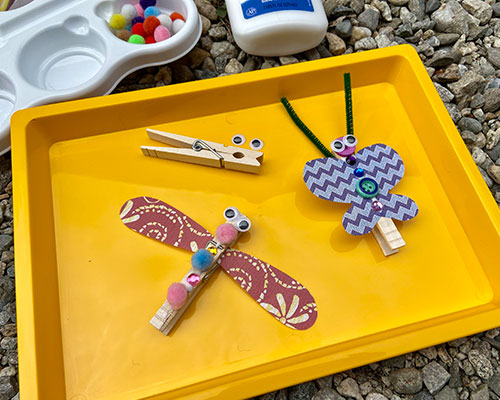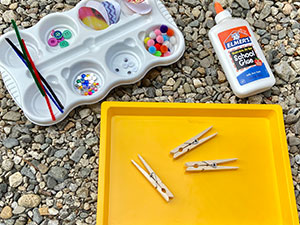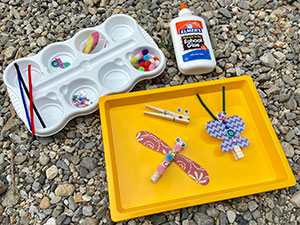Clothespin Bugs

Use a variety of “loose parts” and clothespins to create friendly bugs.
What are loose parts? Loose parts are open-ended and versatile materials that can be used in a variety of ways. They can be found, bought, taken out of your recycling bin, or even taken from other art projects and repurposed. With loose parts children can use their imaginations to create in endless ways. Some examples of loose parts can be found in our materials list below.
Use a variety of “loose parts” and clothespins to create friendly bugs.What are loose parts? Loose parts are open-ended and versatile materials that can be used in a variety of ways. They can be found, bought, taken out of your recycling bin, or even taken from other art projects and repurposed. With loose parts children can use their imaginations to create in endless ways. Some examples of loose parts can be found in our materials list below.
Ages/Grades
Preschool, Early Elementary
Learning Domains
Language, Fine Motor, Social Emotional, Science
Materials
• Glue
• Buttons
• Beads
• Feathers
• Pom poms
• Scissors
• Construction paper or decorative paper
• Any other found or recyclable materials such as; pebbles, mosiaic tiles, paper straws, etc.
Ready, Set, Create!
![]() Place all of the materials out on your tray or work surface.
Place all of the materials out on your tray or work surface.
![]() Organize the materials in an interesting and enticing way, to create an “Invitation to Play.” Try grouping together similar materials or arranging them by size or color.
Organize the materials in an interesting and enticing way, to create an “Invitation to Play.” Try grouping together similar materials or arranging them by size or color.
![]() Encourage children to create bugs by gluing materials onto the clothespin. Children or caregivers can cut the decorative paper or construction paper into wing shapes, if they’d like.
Encourage children to create bugs by gluing materials onto the clothespin. Children or caregivers can cut the decorative paper or construction paper into wing shapes, if they’d like.

![]() When the glue is dry, you can clip them around the classroom to decorate for spring. They can even be clipped onto a potted plant!
When the glue is dry, you can clip them around the classroom to decorate for spring. They can even be clipped onto a potted plant!

Engage Children in Conversation
Comment on what you observe, such as “I notice you put three wiggle eyes on your bug” or “What do you think will happen if you glue the pebbles on top of the wings?”
Ask children open ended questions that encourage critical thinking, such as:
Which materials will you use to create your bug? Why will you choose these materials?
Will you name your bug? What will you name it?
Will your bug be able to fly?
For very young children, try asking “either/or” questions, such as;
Are you using the green or the yellow craft stems for antennas?
Will your bug fly or crawl?
Extensions
Caregivers can place real-life photographs of bugs around the work space for inspiration. Some children may wish to recreate actual bugs, while others may wish to make up their own.
Modifications
![]() Children can use a glue bottle, or can dip a paintbrush into a container of glue if they’re not yet able to squeeze the bottle.
Children can use a glue bottle, or can dip a paintbrush into a container of glue if they’re not yet able to squeeze the bottle.
![]() The children can have help from caregivers with cutting the shapes of wings and other materials, or can use pre-cut items.
The children can have help from caregivers with cutting the shapes of wings and other materials, or can use pre-cut items.
